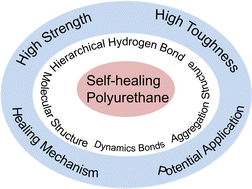Toward mechanically robust self-healing polyurethanes using dynamics chemistry
Abstract
Polyurethanes (PUs) are some of the most potential self-healing materials due to their diversity of soft and hard segment designs. Achieving material self-healing requires high chain mobility, while high strength requires high chain rigidity (immobility). This irreconcilable contradiction makes it difficult to prepare PU elastomers that self-heal under mild conditions and have high strength simultaneously. Due to the characteristic microphase separation structure of PUs, the relationship between the PU structure and performance is multiscale (molecular scale and aggregation scale). In this paper, the molecular structure design strategies of mechanically robust self-healing PUs based on hydrogen bonding are reviewed. The relationships among the molecular structure, hydrogen bonding, aggregation state structure, and mechanical and self-healing properties are described. In addition, other dynamic design strategies for mechanically robust self-healing PUs are also mentioned. As an important part of self-healing research, the research progress of the self-healing mechanism based on experiments and molecular simulations is also reviewed. Finally, the potential applications of self-healing PUs in the biomedical field, anti-corrosion and anti-fouling coatings, energy storage, and wearable devices and sensors are summarized. Meanwhile, the challenges and future research directions of mechanically robust self-healing PUs are discussed.

- This article is part of the themed collections: 2024 Materials Chemistry Frontiers HOT articles and 2024 Materials Chemistry Frontiers Review-type Articles


 Please wait while we load your content...
Please wait while we load your content...